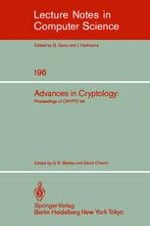1985 | OriginalPaper | Chapter
On Rotation Group and Encryption of Analog Signals
Author : Su-shing Chen
Published in: Advances in Cryptology
Publisher: Springer Berlin Heidelberg
Included in: Professional Book Archive
Activate our intelligent search to find suitable subject content or patents.
Select sections of text to find matching patents with Artificial Intelligence. powered by
Select sections of text to find additional relevant content using AI-assisted search. powered by
The problem of generating randon elements in groups has direct application to cryptography. For instance, we like to know whether the DES permutations are randon permutations of the 264 possible 64-bit words. The whole symmetric group is known to be generated by certain k-functions (7). Another example is the Wyner voice encryption scheme (12) which requires the production of large numbers of random real orthogonal matrices. N. J. A. Sloane has given a survey on this problem (11) which has led to the following questions for a given group G: 1.How does one generate elements of G at random?2.How can one test if certain given elements of G really are random?3.Does a given subset H generate the whole group G?4.If so, how long does it take? In this paper, we consider these questions for the orthogonal group O(d) for any positive integer d. By looking at the Lie algebra o(d) of O(d) and one-parameter subgroups of O(d), we can find the generation of an arbitrary element in terms of one-parameter rotation groups in uniform fashion. The length of generation can be determined. Random elements are generated using random number generator on the real parameter space of each one-parameter subgroup.
